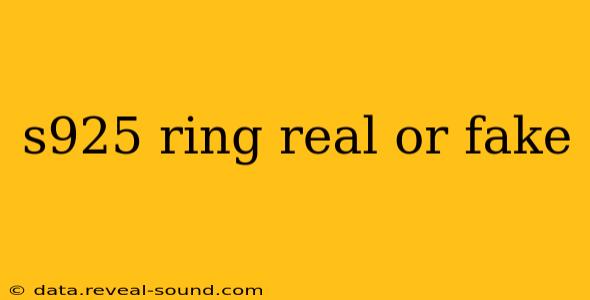The jewelry market is flooded with options, making it crucial to discern genuine sterling silver from imitations. This guide will help you determine if your S925 ring is real or fake, arming you with the knowledge to make informed purchases. The hallmark "S925" indicates sterling silver, a metal alloy composed of 92.5% silver and 7.5% other metals, usually copper. However, the presence of this hallmark isn't a foolproof guarantee of authenticity. Let's delve into the methods for verifying the genuineness of your S925 ring.
How to Tell if an S925 Ring is Real
Several techniques can help you assess the authenticity of your S925 ring:
1. Examine the Hallmark
The most straightforward method is to inspect the hallmark. A genuine S925 ring will typically have the "S925" marking clearly stamped on the inside of the band. However, counterfeiters can sometimes replicate this marking, so this alone isn't conclusive. Look for other markings – reputable jewelers often include additional hallmarks indicating the manufacturer or country of origin. A blurry or poorly stamped hallmark could indicate a fake.
2. The Weight Test
Sterling silver is relatively heavy for its size. Compare your ring to other known sterling silver pieces. A significantly lighter ring of similar size could be a red flag. This method is most effective when comparing to a piece you know is genuine.
3. The Magnet Test
Silver is not magnetic. If a magnet strongly attracts your ring, it's almost certainly not sterling silver. However, keep in mind that some metals used in plating or alloys might exhibit weak magnetic properties. This isn't a definitive test, but a strong magnetic attraction should raise concerns.
4. The Acid Test (Caution!)
This method requires a silver-testing kit, which you can purchase online or at jewelry supply stores. These kits contain a small amount of acid that reacts differently to real and fake silver. Apply a tiny drop of the acid to an inconspicuous area of the ring. A genuine S925 ring will react in a predictable manner according to the kit's instructions (usually a color change). Use extreme caution when performing this test. Always follow the instructions carefully and use proper safety measures.
5. Inspect the Finish
Genuine sterling silver typically has a smooth, consistent finish. Look for uneven coloring, pitting, or a rough texture, which might suggest a lower-quality metal or a plating that's wearing off.
6. Consider the Price
If the price seems too good to be true, it probably is. Be wary of exceptionally cheap S925 rings, as they're more likely to be counterfeit.
Frequently Asked Questions (FAQs)
These are some common questions people ask about S925 rings and their authenticity:
What is the difference between S925 and 925 silver?
There's no practical difference. "S925" and "925" both denote sterling silver, the same alloy of 92.5% silver and 7.5% other metals. The "S" is sometimes used as an abbreviation or might represent a particular manufacturer or region's hallmarking system.
Can S925 silver tarnish?
Yes, S925 silver will tarnish over time due to oxidation. This is a natural process and doesn't indicate the ring is fake. Regular cleaning can help prevent excessive tarnishing.
How can I clean my S925 silver ring?
Gentle cleaning with a soft cloth and mild soap is usually sufficient. Avoid abrasive cleaners or harsh chemicals. Commercial jewelry cleaners specifically formulated for silver are also available.
Where can I get my S925 ring professionally tested?
A reputable jeweler or gemologist can authenticate your ring using professional testing methods. They have access to advanced equipment and expertise to definitively determine its composition.
By using a combination of these methods, you can significantly improve your chances of determining whether your S925 ring is genuine sterling silver. Remember, if you have any doubts, it's always best to seek professional verification.
